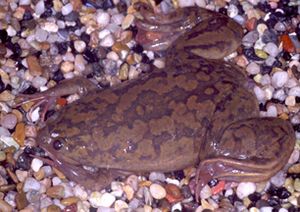Xenopus facts for kids
Quick facts for kids Xenopus |
|
|---|---|
 |
|
| Xenopus laevis | |
| Scientific classification |
|
| Kingdom: | Animalia |
| Phylum: | Chordata |
| Class: | Amphibia |
| Order: | Anura |
| Family: | Pipidae |
| Genus: | Xenopus Wagler, 1827 |
Xenopus is a group of frogs often called clawed frogs. These amazing frogs live in the water and are found in sub-Saharan Africa. There are about 20 different kinds, or species, of Xenopus frogs.
Two of the most famous species are Xenopus laevis and Xenopus tropicalis. Scientists study these frogs a lot. They are known as "model organisms" because they help us understand how living things grow and develop. They also help scientists learn about cells, how bodies react to certain substances, and how the brain works. Studying these frogs can even help us understand human health issues.
Xenopus frogs are also special because of something called "polyploidy." This means some of them have many more sets of chromosomes than most animals. They can have up to 12 sets! These frogs are fantastic swimmers. They have strong, fully webbed feet, which are perfect for moving fast in the water. However, their front fingers do not have webbing. A cool fact is that three toes on each of their back feet have clear black claws. This is where they get their name, "clawed frogs"!
Contents
About Clawed Frogs
Xenopus frogs are unique amphibians that spend most of their lives in water. They are known for their smooth skin and flat bodies. These frogs are very good at adapting to different water environments.
What Makes Them Special?
Clawed frogs have several features that make them stand out.
- Claws: As their name suggests, they have small, sharp claws on three toes of each back foot. These claws help them tear apart food.
- Webbed Feet: Their powerful, fully webbed back feet are perfect for swimming quickly. They use them to push through the water with ease.
- No Tongue: Unlike many other frogs, Xenopus frogs do not have a tongue. They use their front hands to grab food and push it into their mouths.
- Lateral Line System: They have a special system along their sides, similar to fish. This helps them sense movements and vibrations in the water, which is useful for finding food and avoiding danger.
Where Do They Live?
Xenopus frogs are native to sub-Saharan Africa. This region includes many countries south of the Sahara Desert. They live in various freshwater habitats. You can find them in ponds, lakes, and slow-moving rivers. They prefer calm waters where they can swim and hide easily.
Why Are They Studied by Scientists?
Xenopus laevis and Xenopus tropicalis are very important in science.
- Development: Scientists use them to study how embryos grow from a single cell into a complex animal. Their eggs are large and easy to observe.
- Genetics: Because of their unique chromosome sets, they help researchers understand how genes work.
- Health Research: Studies on these frogs can give clues about human diseases and birth defects. This is because many basic life processes are similar across different animals.
Images for kids
See also
 In Spanish: Xenopus para niños
In Spanish: Xenopus para niños


